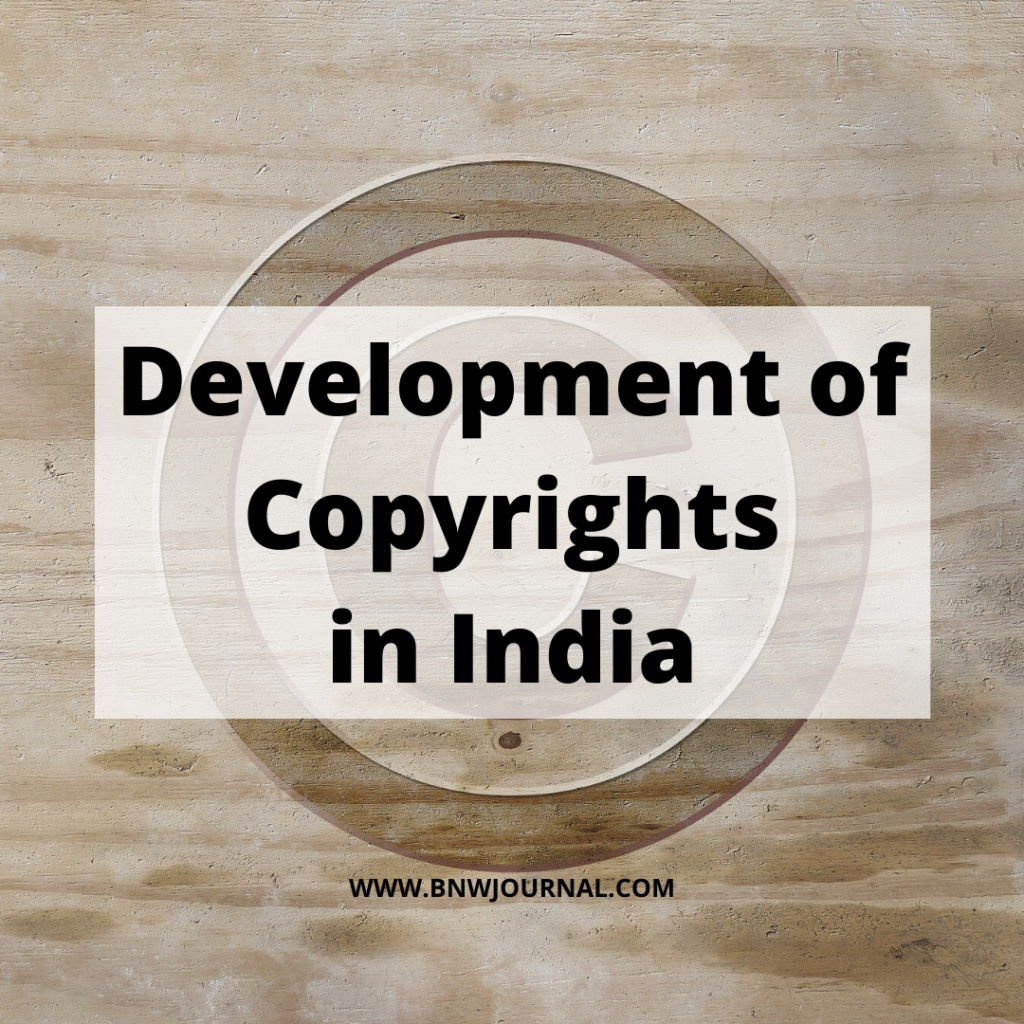![]()
INTRODUCTION
We live in the era of science and creation. Every day there is a creation or invention of a new piece of work. Intellectual Property Rights came into existence to protect these creations and their creators. It expands to the world of science and technology, literature, design, logos and artistic fields. Intellectual property is intangible. Intellectual property gives the rights to the creator to decide the fate of the property. Copyright is a vital branch of Intellectual Property. It is a right which could be exclusive to the creator or could be assignable by the same. The main idea behind this branch of Intellectual Property Right is that if a person creates something then the ownership lies with him/her. It is the right to copy or reproduce the work in which copyright subsists.[1]

Copyright was born as a result of the invention of the Printing Press by Gutenberg in the 15th century. This invention aided reproduction of literary work. The working of copyrights evolved as the world evolved. Technology was one of the major reasons behind the making of amendments in the copyright laws throughout the world.
Copyrights extend to an array of fields like music, literature, drama, art, sound recordings and cinematography. The owner originally owns the copyright only for a specific period after which it can become a public domain.
THE HISTORY AND DEVELOPMENT
The history of copyright laws of India goes back to more than 150 years. India saw a lot of changes and developments in this aspect starting from the British Era to the recent one in 2012. Typically, the evolution of copyright is divisible into three major phases. However, the history of India’s copyright laws are considerably incomplete without including the fourth phase of 2012 amendments to the existing copyright laws.
I. Phase 1 – 1847:
India’s first affair with the copyright laws was under the East India Regime. During that era, any act passed by the Governor-General applied to India.[2] The highlight of this act is giving of the term of copyright to the creator. The creator received the rights for his lifetime plus seven more years after his death (post-mortem). However, in no case would these rights exceed forty-two years in total. Further, if an author refuses to publish his book, the government shall have the power to publish the same upon the author’s death. Unauthorized printing for “sale, hire or export” or “publishing or exposing to sale or hire” was under the ambit of laws relating to infringement. This offence was so grave that it would be heard by the highest local court which exercised original civil jurisdiction.
The 1857 Act had specific provisions regarding “any encyclopaedia, review, magazine, periodical work or work published in a series of books or parts” under a contract of service copyright. The rights in the aforementioned instance shall vest on the “proprietor, projector, publisher or conductor”.
Another important aspect of the Act was regarding the Registration process. It was vital for a creator to register with the Home Office. This step was mandatory if the creator wished to gain protection under this enactment. The Act reserved the subsistence of copyright in the author specifically. An author’s right to sue an infringer for its infringement shall extend to any other available law.
II. Phase 2 – 1914:
United Kingdom constituted a new copyright Act of 1911. An extension of this was enacted in India in 1914. This marked the second phase of Copyright laws in India. 1914 Act had several modifications. Copyright infringement came under the ambit of a criminal offence. It was dealt in Sections 7 to 12 of the 1914 Act. the term of copyright available to an author was reduced drastically to ten years from the date of the first publication. An author would enjoy “sole right” during this term.
This clause was stated in section 4 of the Act. There was a proviso in the clause which stated that if the author publishes his/her work in another language within the term than the original then the author will retain the sole rights for another ten years for that language. Indian Copyright Act 1914 was continually applicable in India until replaced by the Copyright Act 1957.[3]
III. Phase 3 – 1957:
India entered the third phase after attaining freedom. The Copyright Act of 1957 was a pioneer in an uninterrupted copyright law in India. This Act went through several amendments in 1983, 1984, 1992, 1999 and lastly in 2012. This Act was broadly classified into 15 chapters and 79 sections. The central government had the power to make any required rules by the method of notification in the Official Gazette. This clause is governed by section 78 of the Act.
Under this Act, initiation of establishment of a copyright office took place. This office was under the control of the Registrar of Copyrights. Registrar would work as per the guidance of the central government.[4] The main work of the office was to maintain a register which contain name or titles of the work etc.[5] The Registrar of the Copyrights had rights to dispose or allow applications. He also had the power to inquire into complaints of infringement.
Under Section 20 of the Act, a Copyright Board required setting up. Every case that appears before this Board is considerably judicial proceedings.[6] The Act gave exclusive rights to communicate works by radio diffusion. The term of copyright kept altering in accordance to the amendments. It extended from 23 years to 50 and finally 60 years. The right to produce a work of translation was made coextensive with other rights arising out of copyright. Both criminal and civil remedies were made available for infringement. Remedies against groundless threats were also introduced in this Act.
IV. Phase 4 – 2012:
As time progressed India became a part of several world treaties. Two such treaties were the World Intellectual Property Organization Treaties – the WIPO Copyright Treaty (WCT) and WIPO Performances and Phonograms Treaty (WPPT). It was now important to keep the copyright laws of India in harmony with these international treaties. Therefore, both houses of the Indian Parliament in jointly passed the Copyright Amendment Bill, 2012. This was in compliance with both treaties.
This Act worked on extending the rights of the performers and the broadcasters. One of the main agendas was to eliminate unequal treatment given to the lyricist and music composers of their copyright creations used in cinematographic films. It ensured royalties to the music composers and the authors. Further, exclusive moral and economical rights were bestowed over the performers.
CONCLUSION
In today’s era, the world has realised the importance of protecting its creations and inventions. Thus, intellectual property took birth and evolved. Copyright has walked a long journey since the invention of the printing press. As the world progresses the law of copyright shall develop as law needs to walk at par with the society.
References:
[1] S.D. Geet & A. A. Deshpande, Legal Aspects of Business, Nirali Prakashan, 2008, at 9-22.
[2] Kala Thairani, How Copyright Works in Practice, 1996, at 2
[3] V.K Ahuja, Law of Copyright and Neighbouring Rights: National and International Perspectives, 2007, p.2-3
[4] Section9, Copyright Act, 1957.
[5] Section 44 and 45, Copyright Act, 1957
[6] Section12, Copyright Act, 1957



0 Comments